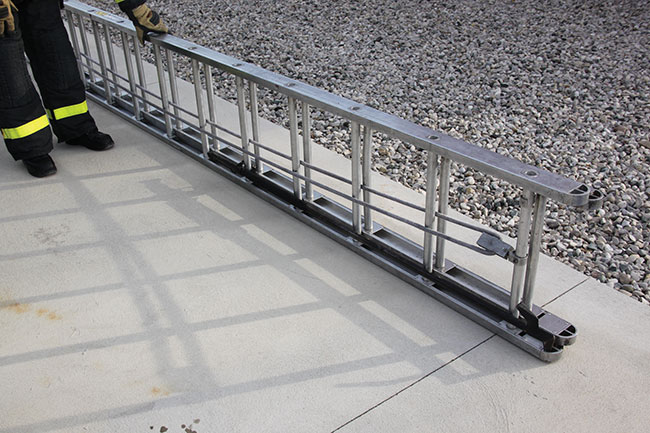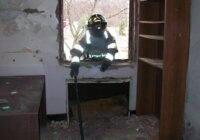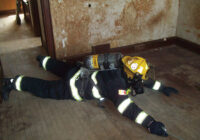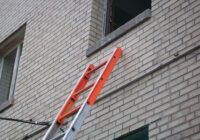
Features
Back to Basics: The tenets of VES, Part 2
August 19, 2022
By
Mark van
 An example of a roof hook bedded with a ground ladder. Photos by Mark van der Feyst
An example of a roof hook bedded with a ground ladder. Photos by Mark van der Feyst
In our last issue, we started to look at the basic tenets of a tactic called Vent, Enter, Search (VES). In Part 1 we explored what VES is and how it can be used by the first arriving unit on scene. In Part 2, we are going to look at the tools needed for VES and the steps to performing it.
There are basic tools that are going to be needed when performing this tactic: a halligan, a six-foot roof hook and a search light. Most fire trucks are equipped with pike poles instead of roof hooks, but the roof hook is preferred over the pike pole. In Photo 1, you will see an example of a roof hook bedded with a ground ladder. The roof hook is smaller in diameter than a pike pole, made from aircraft steel and designed for multiple purposes compared to the pike pole. The roof hook can be used to pry, strike and force a window very easily. The pike pole made from fiber glass will not sustain the forces or striking required to clear out a window sash or glass and is much thicker in diameter to carry.
As shown in Photo 1, the roof hook is paired with a ground ladder so that two tools can be carried at once. The pike pole is not able to be paired with any ground ladder, thus forcing a firefighter to have to carry it separately. The roof hook will be used to break the window, clear the window sash and glass, and provide a descending ramp into the room. The six-foot length is a perfect fit for any size room for maneuverability.
The halligan is going to be used to assist with the search of the room as well as possibly being used as a door wedge to keep the door shut if need be. A search light is a box light and not a right-angled flashlight. The right-angled lights are personal flashlights and will not provide what is needed for a search light. With a box light, we will have higher lumens to use to our advantage.
If VES is performed on a two-story or higher floor, then a ground ladder will be needed as part of the basic tools needed. Another tool will be the thermal imager, to assist with the search, watching the conditions and for accountability of the firefighter inside the room.
To perform this tactic, the first action step is to vent the room if it is not already vented. One way to accomplish this is to use the roof hook. This will allow the firefighter to stand to the side of the window for a single-story. For a two-story building, the firefighter can be positioned on the ladder so that their head is below the windowsill. Prior to breaking the glass, look inside the window quickly to see what is going on inside the room. Be sure to clear out the window completely, including the glass, sash, curtains, and anything else that may be in the way. This will ensure no interference with getting in and out.
- The roof hook can be used as a ramp.
- The immediate search area is going to be the length of the firefighter’s body.
- Make sure to ladder the tip just below the sill.
With the room vented, the firefighter will now enter. Prior to entering, take the roof hook and sweep the area below the window to see if there is anyone lying there. Once done, the roof hook can be used as a ramp as shown in Photo 2. This will help with getting into a room where the sill height is greater than three feet and prevent falling head-first into the room.
Once inside the room, the firefighter needs to locate the bedroom door so that it can be closed. This will be done by using the search light and putting the firefighter’s head right on the floor. With the head on the floor, the firefighter can shine their light across the floor to see what is below the smoke layer, locate the door and possibly the occupant that is still inside. The main purpose of doing this is to locate the bedroom door.
Once the door has been located, the firefighter needs to head in a straight line right to it. Once at the bedroom door, the firefighter will do a quick search of the immediate area outside of the door. This search area is going to be the length of the firefighter’s body as shown in Photo 3. In this area, we may find an occupant who was trying to leave the structure but succumbed to effects of the fire and fell right there. If there is a person lying there, grab them and pull them back into the room, then close the door. If on the way to the door, the firefighter comes across an occupant, close the door first, then go back for them. The door needs to be closed so that the flow path that has been created will be stopped. If the door is not closed, then the fire will travel to the new vented opening and create more problems for all involved.
With the door being closed, the firefighter can now search the room. This will be a primary search looking for occupants on the floor, on their bed, under their bed, closet floor, on top of a bunk bed and in the crib. Once located, they will be brought to the window by dragging them there, and then removed out the window to outside. If this is a second-story room, they will be brought down the ground ladder. Once the room has been searched and cleared, the firefighter will get out the same way they came in.
On a second-story window, make sure to ladder the tip just below the sill as shown in Photo 4. This will prevent any obstructions to getting and out of the window. The second firefighter will stay at the window either on the ground or on the ground ladder and they can use the thermal imager to guide the search, monitor the conditions and the firefighter that is inside.
What has been detailed here is a short synopsis of doing VES – the best way to understand it to seek out a person who has done it before and have them walk the crew through it for practice sakes.
Editor’s historical note: 2023 will mark 15 years of Back to Basics. Thank you for being a long-time contributor, Mark!
Mark van der Feyst has been in the fire service since 1999 and is currently a firefighter with the FGFD. He is an international instructor teaching in Canada, the United States, FDIC and India. He is a local level suppression instructor for the Pennsylvania State Fire Academy and the lead author of Fire Engineering’s Residential Fire Rescue book and other DVDs. He can be contacted at Mark@FireStarTraining.com.
Print this page


